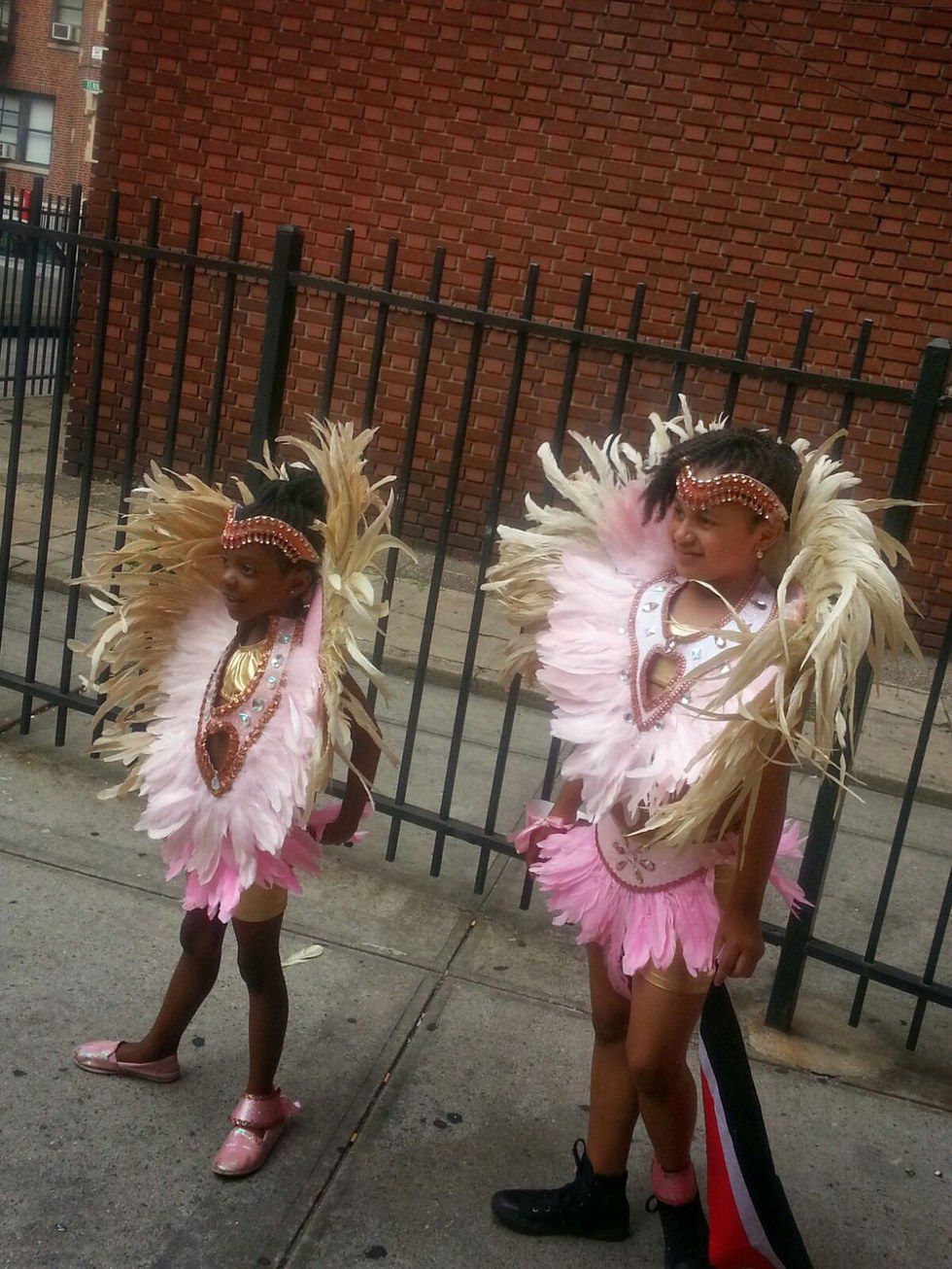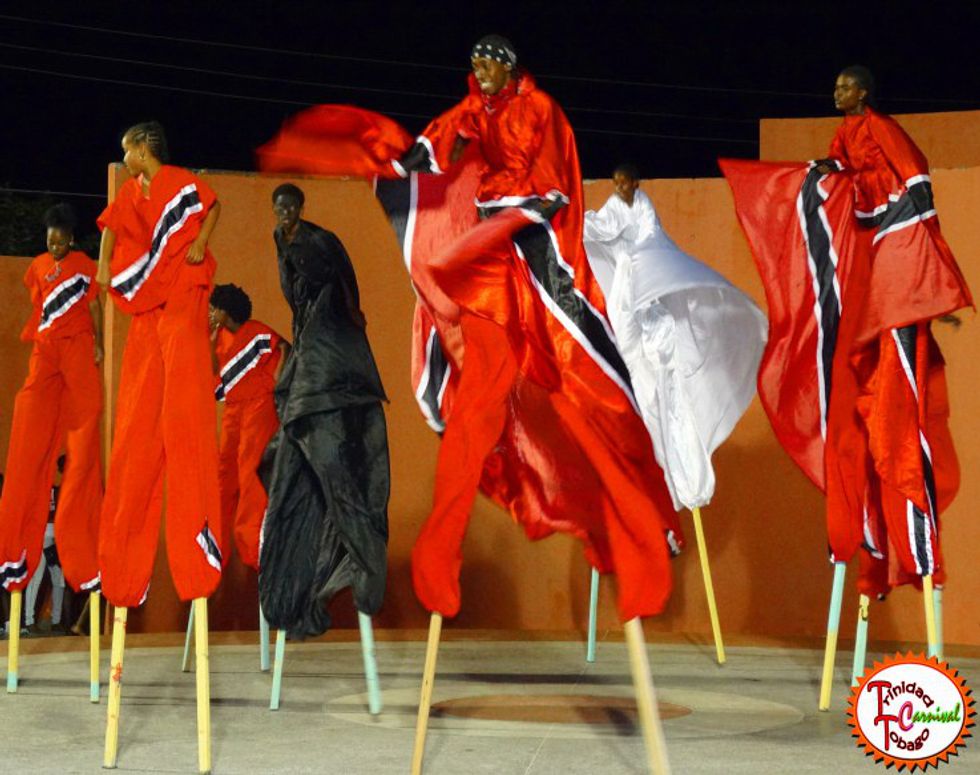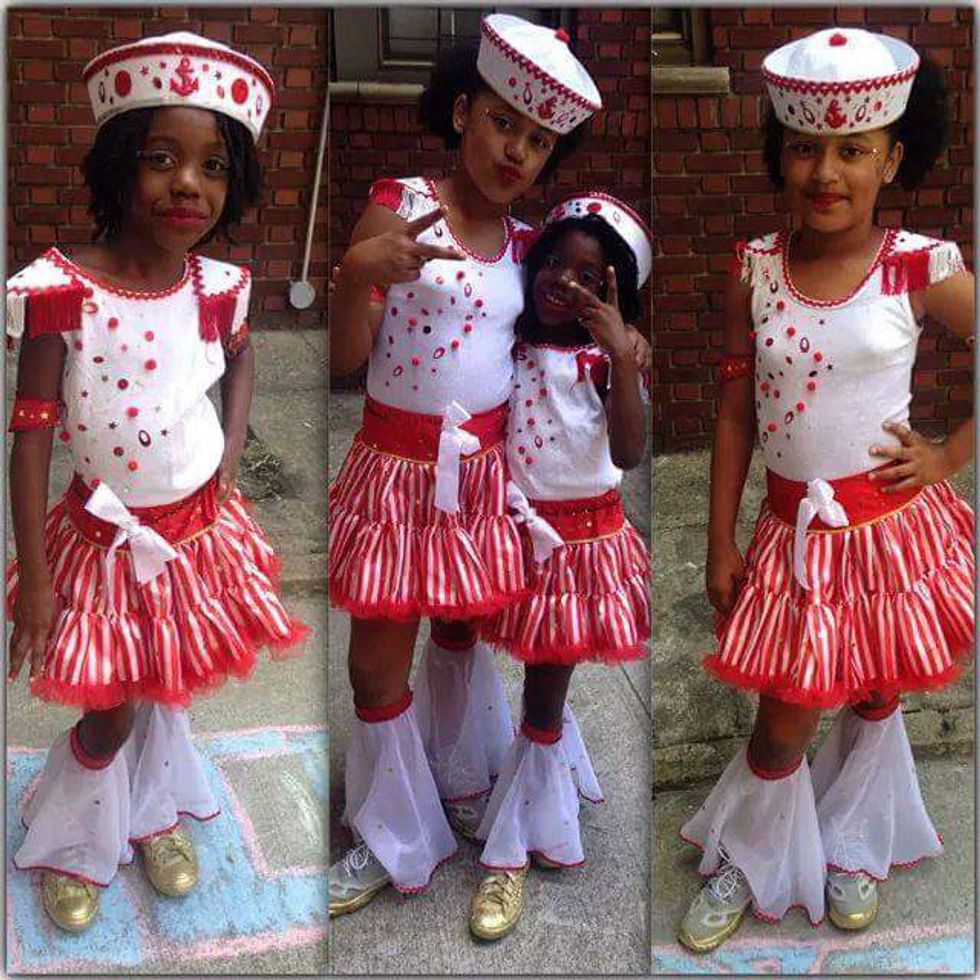Three generations of Miss B's family have enjoyed participating in the West Indian Day Parade that takes place every year in New York City. Miss B lives in Flatbush, Brooklyn, and joined the New Generation band with her daughter, who makes costumes by hand, and her grandchildren who have played in the Kiddie Carnival, the children's section of the parade, for the past six years.
The children's costumes begin as wire frames that her daughter decorates “with perfection,” Miss B said. In one case, a child is transformed into a large pink bird, with each wing bent one by one and fitted with a headpiece. A type of starch glue is made from newspaper, boiled and mixed to create a paste that is shaped over the bent wire to form a bird.
The final touches of the costume are applied when “she [adorns] it with different feathers and stones to get a beautiful effect of whatever the wire is stretched into,” Miss B said.
The whole process takes three to four hours for one costume, and costs about $350 for a front-line with wings and around $200 for a back-line.
“You have to know and see beauty,” Miss B said about the skill it takes to create such intricate costumes.
Besides her love of the flamboyant and colorful costumes, Miss B believes it is important to continue traditions “so the younger generations can know who they are, where they come from, and what their ancestors went through."
Longtime participants of the parade feel the changing demographic of Brooklyn neighborhoods and the pressure of increased rents create a threat to iconic cultural traditions like the West Indian Day Parade.
The West Indian Day Parade, also known as the New York Caribbean Carnival Parade, takes place every year on Labor Day in Crown Heights, Brooklyn. It has become a gateway for Caribbean-Americans to reconnect with their culture, honor their ancestors and share in the festivities with all of New York City.
Ricardo Watson, a designer and costume maker for Phoenix International Mas Band, based in Crown Heights, Brooklyn, told the Gothamist just earlier this year that he is tired of fighting with the rising rents and drastic decline in customers; it has just become too costly. According to the Gothamist, “Phoenix usually marches 100 strong on parade day, but as of last week, only 20 dancers had bought costumes and were planning to participate.” Watson also told the Gothamist he is planning to retire next year.
According to the West Indian American Day Carnival Association (WIADCA), the parade began in the 1930s when a woman named Jessie Wardell from Trinidad and Tobago and a group of her West Indian friends started an indoor carnival in Harlem. The need to be outdoors dancing, marching and celebrating took the carnival to the streets of Harlem in 1940 when Wardell got a street permit. It was 20 years later when another Trinidadian, a man named Rufus Goring, brought the carnival to Brooklyn. Since then, the parade “has grown over the years from thousands of participants and tourists to over 1 million people in attendance since the mid-1990's according to then-Mayor Rudy Giuliani.”
According to Time Out New York, this year the carnival drew “close to two million people to Crown Heights, Brooklyn, in September.”
Despite the growth and continued support of the parade, it has become costly to continue the tradition. The WIADCA is the official group that organizes the parade each year and is made up of unpaid volunteers who quite frankly can't afford to do it for much longer.
Jean Alexandra, one of the secretaries for the WIADCA, whose office is based in downtown Brooklyn, laughed wholeheartedly when asked what went into putting together the parade. According to Alexandra, they start putting everything together for the carnival at least one year in advance.
“There are tens of thousands of pieces that goes into putting it together,” Alexandra said. The elaborate festival encourages hundreds of food vendors and official bands that start marching down Eastern Parkway from the night before the parade in a ritual called J'ouvert. Vendors selling flags from the different Caribbean islands, bells, whistles and other trinkets also join in the mix.
“Everyone makes money except the organization that puts it all together, and that needs to change,” Alexandra said. “We are all [unpaid] volunteers.”
The History
“Historians believe the first 'modern' Caribbean Carnival to have originated in Trinidad and Tobago in the late 18th century, as a flood of French emigres brought the Masquerade tradition with them to the island,” according to an article published by travel writer Christopher Curley on Go Caribbean.
Miss B goes a little more in-depth by explaining that the tradition began in the ancient times when the slaves used carnival as a way to “come out of that slavery and bondage by playing it off.”
At the time, blacks who were enslaved in the islands were not allowed to enjoy the elaborate masquerade balls. So they came up with their own tradition. “They used to do perfection of a mass to demonstrate what anger and frustration and negativeness would be played off to them,” Miss B. said.
“With the end of slavery in 1834, the now completely free populace could outwardly celebrate their native culture and their emancipation through dress, music and dancing,” wrote Curley in his article, "A Brief History of Carnival in the Caribbean."
The Characters
Over the years, the Carnival has grown to an elaborate festival enjoyed by many New Yorkers. Many bands have gained prominence and popularity over others due to their eye-catching costumes and commitment to the culture. Some characters have history deeply rooted in times of slavery and hold significance in honoring the ancestors of Africans and the blood shed during those dark times.
The Jab Jab is a well known character band who hit the streets during J'ouvert, and whose painted skin, raunchy behavior, chains around their necks, horns and tails personify both evil and slavery. A video blogger named Stephanie Keith followed the Jab Jab band one year ago, capturing the magic behind the dark painted skin as it was illuminated on the parkway in the twilight hours just before the parade. “As the Jab Jab you have power—to take over the streets, be sexy, to do what you want without any interference from police,” wrote Keith in her video blog. “The Jab Jab is an important part of African Diasporan street theater giving people a release from their everyday lives and allowing them to rewrite a cruel piece of Caribbean history.”
The Moko Jumbie is more of a daytime character walking throughout the parade on high stilts, dancing and spreading cheer. According to the Traditional Mas Archive's website, the Moko Jumbie's stilts can be anywhere from 10 to 15 feet high. The character's name is a combination of Moko, which stems from the West African orisha or god, and Jumbie, the Trinidadian term for spirit or ghost. The Moko Jumbie is said to represent fate and retribution and “even as he endured centuries of brutal treatment he remains ‘tall tall tall’,” wrote Milla Cozart Riggio in her book entitled, "Carnival: Culture in Action—The Trinidad Experience."
The King and Queen are other popular band characters in the parade who are usually admired for their elaborate costumes and beautiful men and women. As its name implies, the band consists of two main figures: the King and the Queen. They lead the section and usually wear massive costumes that can take the shape of an animal or other structures. The King and Queen are followed by the rest of the band wearing smaller and less extravagant costumes. These characters can be seen as a tribute to the beauty of the black man and woman who have been historically brutalized and is constantly over-sexualized.
While admiring the beauty of these costumes, the music from the bands and the different forms of Caribbean cuisine available at the parade, many are unaware of the historical significance and the empowering message behind these characters for all people of African decent.
The Music
The music is the main part of the festivities. Without the different bands representing different characters and different islands in the Caribbean and Americas, there would be no West Indian Day Parade. Popular instruments include the steel pan, which is a steel drum-like instrument originating from Trinidad and Tobago, and the traditional drums. Both instruments can be traced back to the times of enslaved Africans.
According to Miss B, the drums were "the way we talked to our late ancestors and asked them for guidance and protection... The drums give them a little more empowerment."
Drums have long been a part of African tradition. A blog called Africa imports talks about the importance of drums in African culture, stating, “The vicious sound of many drums pounding together is also a necessary installment to stir up emotions in a battle or war to inspire excitement and passion.”
Continuing Tradition
Today, the tradition of the West Indian Day Parade has become an escape from the everyday bustle of this city according to Jennifer Matthews, a Brooklyn woman who has been participating in the parade since she was 13 years old. Matthews, who is now 28, believes, “We live in a culture (American culture) where it can be very easy to lose who you are.” She works a full-time job and deals with the city's “rush hour” and “angry people” on a daily basis.
“The parade brings me back to life,” said Matthews.
11-year-old Akira Cruz was only five when she played mass for the first time with her little sister. Her grandmother, Miss B, said she made sure her children and their children would continue the tradition that she felt connected them to their ancestors.
“It was shocking and exciting,” said Cruz, describing her first time participating in the parade. She went on to say, “I got to dance and meet new people and hang out with my family.” It was a time where Cruz and other children got to bond and learn more about their culture and themselves, “because not every other culture does it like us.”
The parade is set to continue next year on Labor Day at the end of summer in 2016. The volunteers from the WIADCA have already begun their tedious work of organizing all the small pieces that make up for the huge carnival. Gentrification and its effects guarantee more problems for the overworked and unpaid workers to address in the coming year.
Newcomers to Brooklyn pose a threat because “they come with different perspectives and don't understand the culture so they make noise complaints and try to shut the functions down early,” said a musician who refused to give their name.
Crown Heights is changing like many other neighborhoods in Brooklyn, but Miss B says her family will continue the tradition of playing mass because it's more than just a festive carnival. It is an important part of their history that must be carried on.










































